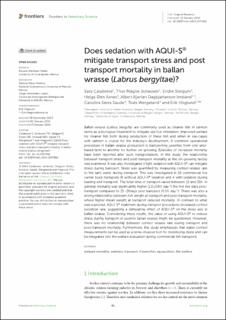| dc.contributor.author | Calabrese, Sara | |
| dc.contributor.author | Jonassen, Thor Magne | |
| dc.contributor.author | Steigum, Endre | |
| dc.contributor.author | Åsnes, Helga Øen | |
| dc.contributor.author | Imsland, Albert | |
| dc.contributor.author | Saude, Carolina Serra | |
| dc.contributor.author | Wergeland, Truls | |
| dc.contributor.author | Höglund, Erik | |
| dc.date.accessioned | 2024-02-15T09:38:08Z | |
| dc.date.available | 2024-02-15T09:38:08Z | |
| dc.date.created | 2024-02-13T10:32:38Z | |
| dc.date.issued | 2024 | |
| dc.identifier.citation | Frontiers in Veterinary Science. 2024, 11:1347062. | en_US |
| dc.identifier.issn | 2297-1769 | |
| dc.identifier.uri | https://hdl.handle.net/11250/3117919 | |
| dc.description.abstract | Ballan wrasse (Labrus bergylta) are commonly used as cleaner fish in salmon farms as a biological treatment to mitigate sea lice infestation. Improved welfare for cleaner fish both during production of these fish and when in sea-cages with salmon is crucial for the industry’s development. A common operational procedure in ballan wrasse production is transporting juveniles from one land-based farm to another for further on-growing. Episodes of increased mortality have been reported after such transportations. In this study, the relationship between transport stress and post-transport mortality at the on-growing facility was examined. It was also investigated if light sedation with AQUI-S® can mitigate stress during transport. Stress was quantified by measuring cortisol release rate to the tank water during transport. This was investigated in 10 commercial live carrier truck transports (6 without AQUI-S® sedation and 4 with sedation during loading and transport). The total time of transport varied between 12 and 21 h. In general, mortality was significantly higher (1.0 ± 0.6% day−1) the first five days post-transport compared to 15–20 days post transport (0.5% day−1). There was also a strong relationship between fish weight at transport and post-transport mortality, where higher mean weight at transport reduced mortality. In contrast to what was expected, AQUI-S® treatment during transport procedures increased cortisol excretion rate, suggesting a stimulating effect of AQUI-S® on the stress axis in ballan wrasse. Considering these results, the value of using AQUI-S® to reduce stress during transport of juvenile ballan wrasse might be questioned. However, there was no relationship between cortisol release rate during transport and post-transport mortality. Furthermore, this study emphasizes that water cortisol measurements can be used as a none-invasive tool for monitoring stress and can be integrated into the welfare evaluation during commercial fish transports. | en_US |
| dc.language.iso | eng | en_US |
| dc.publisher | Frontiers | en_US |
| dc.rights | Navngivelse 4.0 Internasjonal | * |
| dc.rights.uri | http://creativecommons.org/licenses/by/4.0/deed.no | * |
| dc.title | Does sedation with AQUI-S® mitigate transport stress and post transport mortality in ballan wrasse (Labrus bergyltae)? | en_US |
| dc.type | Peer reviewed | en_US |
| dc.type | Journal article | en_US |
| dc.description.version | publishedVersion | en_US |
| dc.rights.holder | © 2024 The Authors | en_US |
| dc.source.pagenumber | 7 | en_US |
| dc.source.volume | 11 | en_US |
| dc.source.journal | Frontiers in Veterinary Science | en_US |
| dc.identifier.doi | 10.3389/fvets.2024.1347062 | |
| dc.identifier.cristin | 2245393 | |
| dc.source.articlenumber | 1347062 | en_US |
| cristin.ispublished | true | |
| cristin.fulltext | original | |
| cristin.qualitycode | 1 | |

